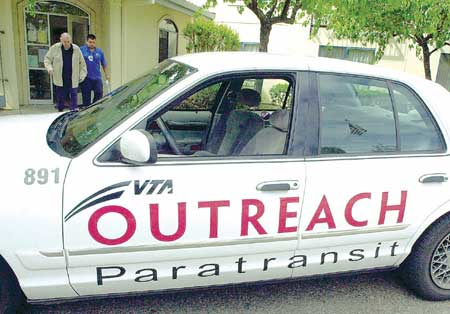One-way ticket for paratransit service goes up 20 cents to
$3
While the cost for South Valley residents relying on the Valley Transportation Service’s paratransit rides will increase 20 cents for a one-way ticket beginning Aug. 1, an additional surcharge will not hit local paratransit service for another year.
VTA paratransit service vans provide rides to seniors and disabled citizens who due to physical limitations can’t ride buses or walk to bus stops.
Excluding South Valley, the VTA is planning to initiate a $6 surcharge each way to paratransit riders traveling to a destination more than three-fourths of a mile outside current VTA buslines and service areas.
For example, if a paratransit rider is going to medical center along a bus route, the cost of the one-way fare will be $3. But if the rider’s destination is a friend’s home on the outskirts of VTA bus routes, the cost will be $9.
The price for a one-way ticket will go from $2.80 to $3.
Other fare changes effective Aug. 1 are: Adult single ride: $1.50; day pass, $4.50; Adult express $3 and $9; Youth (5-17) $1.25 and $3.75; Senior (65 and over) and disabled: $0.75 and $1.75.
The surcharge will be effective Oct. 13 in the unincorporated area of South Valley and every city in the county except Gilroy and Morgan Hill where the surcharge won’t go into effect until July 2004, according to VTA spokeswoman Kat Mereigh.
Mereigh said Gilroy Mayor Tom Springer – a VTA board member – suggested the South Valley deferment, pointing out special circumstances of area paratransit riders.
“The surcharge is a compromise to avoid cutting more of the current service areas,” Mereigh said. “Our goal right now is to maintain the service level we currently have, but to do that we have to raise costs somewhere.”
The VTA is currently at an unprecedented financial crossroads. Officials have estimated the likelihood of a reoccurring $160 million annual deficit.
Nearly 85 percent of the VTA’s operating budget is comprised of sales-tax revenues, which have fluctuated dramatically with the economy. With the current economic downturn, agency revenues have dropped 33 percent in two years after now eight consecutive quarters of declining sales taxes.
Paratransit service accounts for 4 percent of VTA’s annual ridership, logging 40,000 trips per year throughout the county. according to Mereigh.
Massive layoffs and service reductions equaling 21 percent were originally planned for October, but in June the agency’s board voted to defer the cuts by borrowing against future sales-tax revenue projected from Measure A – the half-cent sales tax for transit expansion and operations that county voters approved in 2000.
Future cuts are now planned to be delayed until January.
In the last two years, the VTA has reduced bus and light-rail service 14 percent, cut more than 550 positions, raised fares by 15 percent, deferred $115 million in capital projects and made other moves designed to improve efficiency to help address the budget crunch.
Details: www.vta.org








